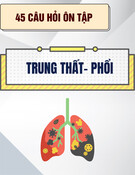
1
JOURNAL OF MEDICAL RESEARCH
JMR 184 E15 (11) - 2024
Corresponding author: Dau Thuy Duong
Hanoi Medical University
Email: dauthuyduong@hmu.edu.vn
Received: 15/05/2024
Accepted: 03/06/2024
I. INTRODUCTION
EFFECTS OF PHUONG DONG DAI TRANG TABLETS ON
INTESTINAL MOTILITY IN EXPERIMENTAL ANIMALS
Tran Thanh Tung, Pham Thi Van Anh and Dau Thuy Duong
Hanoi Medical University
Phuong Dong Dai Trang tablets (PDDT) prepared from several medicinal plants, including Hedychium
coronarium, Coix lacryma-jobi, Dioscorea persimilis, Cynara Scolymus L., Paeonia lactiflora, Glochidion
eriocarpum, are intended to treat gastrointestinal function disorders. This study was carried out to evaluate the
effects of PDDT on intestinal motility in vivo and ex vivo. Swiss mice were divided into four groups that were
given orally 0.9% sodium chloride, Duspatalin (mebeverine) 80 mg/kg b.w./day, PDDT 1080 mg/kg b.w./day
and PDDT 3240 mg/kg/b.w./day, respectively for 5 days. The activated charcoal movements were measured
20 minutes and 40 minutes after all mice were fed with 0.2 ml of 10% activated charcoal. New Zealand White
rabbit’s isolated intestinal segments were divided into two groups with two concentrations of PDDT 1350
mg/100 ml Tyrode’s solution and 2025 mg/100 ml Tyrode’s solution, respectively. The intestine’s contractile
frequency and amplitude were recorded. Our results showed that both doses of PDDT reduced the intestinal
motility in mice and reduced the contractile frequency and amplitude in the rabbit’s isolated intestinal segments.
Keywords: Phuong Dong Dai Trang tablets, mice, intestinal motility, rabbits, isolated intestinal segments.
The gastrointestinal system is a system of
many organs, whose function is to break down
food and absorb nutrients for human daily
activities. Therefore, any organ dysfunction
in this system can affect the body’s ability to
digest food and absorb nutrients.1 To date,
gastrointestinal diseases have become
one of the leading causes of burden and
death worldwide.2 Among them, functional
gastrointestinal diseases such as functional
dyspepsia, and irritable bowel syndrome are
common with varied pathological conditions.3
These diseases impair the patients’ health-
related quality of life and the ability to work.4
The mechanisms of functional
gastrointestinal diseases are mostly related to
the gastrointestinal motility disorders. There
are several chemical drugs used to treat these
diseases. However, they can cause a number
of adverse effects, that leads to the need for
safer and more effective treatment therapies.5
Herbal preparations as complementary and
alternative medicine have been used to treat
these diseases in many countries, including
Vietnam. It is found that herbal preparations are
composed of multiple herbal ingredients which
contain multiple biologically active compounds
on multiple pathophysiological targets.5
Phuong Dong Dai Trang tablet (PDDT) is a
herbal product which is prepared from herbal
ingredients including Hedychium coronarium,
Coix lacryma-jobi, Dioscorea persimilis, Cynara
Scolymus L., Paeonia lactiflora, Glochidion
eriocarpum. These medicinal plants have
been used in traditional medicine to treat
gastrointestinal diseases, including functional






























